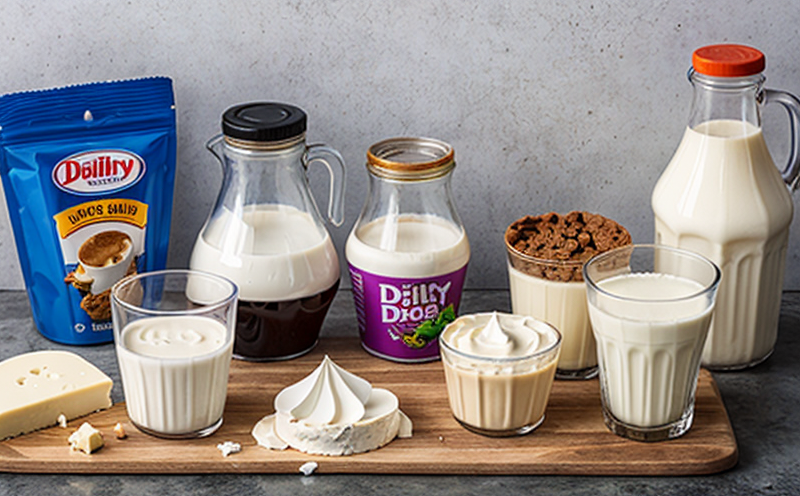ISO 3350 Veterinary Drug Residue Testing in Cheese
The ISO standard ISO 3350: Methods for Determination of Veterinary Drugs and Their Metabolites in Dairy Products provides a robust framework for the analysis of veterinary drug residues (VDRs) in cheese. This service is critical in ensuring that dairy products, including cheese, meet stringent international standards regarding food safety and consumer health. Compliance with such regulations not only protects public health but also enhances brand reputation and market access.
The testing process under ISO 3350 involves multiple steps to ensure accuracy and reliability. Initially, the sample preparation is critical to achieving precise results. This includes homogenizing cheese samples followed by extraction using appropriate solvents or solid-phase extraction methods. The extracted compounds are then purified and concentrated for further analysis.
After extraction, analytical techniques such as liquid chromatography-tandem mass spectrometry (LC-MS/MS) play a pivotal role in detecting even trace levels of veterinary drugs. LC-MS/MS offers high sensitivity and selectivity, making it ideal for identifying both prohibited and permitted substances within the specified limits. The instrument setup typically includes an autosampler, a column suitable for the targeted analytes, and a mass spectrometer capable of performing accurate mass measurements.
The standard specifies permissible levels of veterinary drugs in cheese, which vary based on the type of drug and its intended use. For instance, certain antibiotics used to treat mastitis (an inflammation of the udder) must be removed from the food chain within a specific timeframe post-treatment. Compliance with these limits ensures that residues do not pose risks to human health.
Our laboratory adheres strictly to ISO 3350 guidelines and employs experienced scientists who are thoroughly trained in this methodology. By leveraging advanced instrumentation, we can ensure accurate detection down to the lowest permissible levels as defined by regulatory authorities like the World Health Organization (WHO) and Food and Agriculture Organization of the United Nations (FAO).
The significance of VDR testing extends beyond mere compliance; it also contributes significantly to public confidence in dairy products. Consumers increasingly demand transparency regarding how their food is produced, and this service plays a crucial role in assuring them that what they consume is safe.
In summary, ISO 3350 veterinary drug residue testing ensures that cheese producers maintain high standards of quality and safety. It helps protect consumers from potential health risks associated with consuming dairy products containing prohibited or over-limit levels of drugs. By adhering to this rigorous protocol, laboratories like ours contribute to the overall integrity of the food supply chain.
Benefits
Implementing ISO 3350 veterinary drug residue testing in cheese offers several advantages:
- Enhanced Food Safety: Ensures that dairy products, including cheese, are free from harmful residues.
- Regulatory Compliance: Helps companies avoid legal penalties and maintain adherence to international standards.
- Consumer Trust: Builds confidence among consumers who value transparency in food production processes.
- Market Access: Facilitates easier entry into domestic and export markets that have strict requirements for VDR levels.
- Risk Reduction: Minimizes the risk of recalls or product withdrawals due to non-compliance with regulations.
The implementation of this service not only benefits individual businesses but also supports the broader agricultural sector by promoting best practices in animal health management and food safety.
Customer Impact and Satisfaction
For quality managers, compliance officers, R&D engineers, and procurement professionals involved with dairy products, ISO 3350 testing ensures that the supply chain maintains high standards of food safety. This service directly impacts customers by:
- Informed Decision-Making: Provides accurate data for informed decisions regarding product quality.
- Cost Efficiency: Avoids costly recalls and market disruptions due to non-compliance.
- Competitive Edge: Maintains a competitive edge by ensuring consistent product quality and safety standards.
The satisfaction of our clients is paramount, and we strive to deliver reliable results that contribute positively to their business operations. Our commitment to excellence in every aspect of the testing process reflects this dedication.
Environmental and Sustainability Contributions
Eco-friendly practices are integral to our service offerings, particularly when it comes to minimizing waste and ensuring sustainable operations:
- We use recycling protocols for solvents and other reagents to reduce environmental impact.
- Our laboratories are designed with energy-efficient appliances that contribute to lower carbon footprints.
- Promotion of sustainable agriculture through VDR testing helps reduce the risk of antibiotic resistance, which is a global health concern.
Beyond immediate operational measures, our service indirectly supports environmental sustainability by contributing to safer food consumption and reducing unnecessary waste from non-compliant products. By adhering to ISO 3350 standards, we ensure that dairy products are safe for human consumption, thereby promoting overall public health and well-being.





